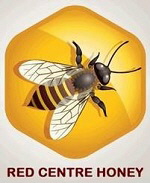Learn more about how Northern Territory bees pollinate plants today
A beehive has a colony of bees with three classes of bees; a Queen, workers and drones. Knowing how beehives operate is interesting and rewarding. Whether you need information for an assignment, you’re simply interested, or you are looking to get into beekeeping, our informative bee facts are sure to have all the information you need to know.
If you want to find out more or are interested in our products, contact Red Centre Honey and talk to our team today.
Life in a Beehive
The Hive
Inside a beehive there are frames for a Queen to lay her brood and store pollen and honey. The frame cells are hexagonal in shape, and produce the well-known honeycomb look. The cells are used to store eggs, larvae, pupae, honey and pollen. Life in the hive is different for each class of bee, and each bee has a specific role to play.
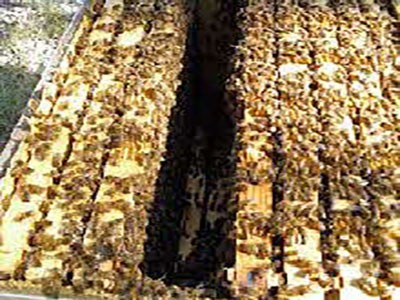
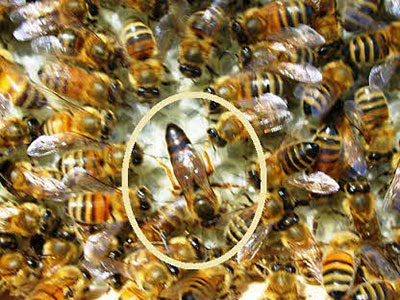
The Queen Bee
Each colony has one queen bee. The queen bee is the largest bee and her job is to lay eggs. These eggs produce male and female bees. Her body is specially formed for laying eggs, so that they can be placed a little above the centre of the cells in the honeycomb. Before depositing the eggs, she inspects each cell, to be sure that the workers have properly cleaned it.
When the colony needs a new queen, extra royal jelly is fed to a chosen larva in the cells. The first queen to emerge will destroy all other developing queens in their cells. Then, after five to twelve days, she sets out on her mating flight. The old queen will have left the hive with a swarm of bees. The new queen, surrounded by worker bees who feed and groom her, can lay up to 2,000 eggs in one day.
Drones
The only purpose of the drone is to mate with the new queen. They cannot make wax and they can’t collect pollen or nectar, as they don’t have pollen baskets on their legs. They never defend the hive, so they also have no need for a sting. They rarely feed themselves and await the day the young queen will fly from the hive. After they mate with the queen their life is over—by the time they reach the ground, they are dead.
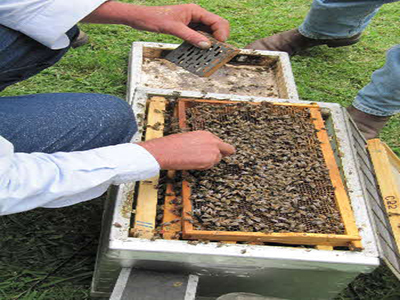
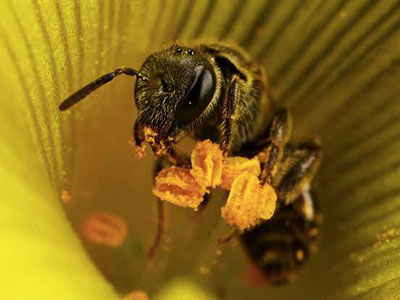
Worker Bees
Workers are female bees who do not normally lay eggs, and have an average life of 4–6 weeks. They have several jobs during their life; starting as a hive nurse they will clean and cap cells as well as feed the drones, queen, and brood. Later, they receive and store nectar from older workers, pack pollen, build honeycomb, and clean the hive. Their next job is honey ripeners, and then as hive guards, where they will prevent bees from other colonies and pests, such as wasps, from entering their hive. Finally, they become foragers, searching for and collecting nectar, pollen and water. They also collect plant resin to make propolis.
Pollination
When bees fly from one flower to another, they collect pollen from the male anthers of one flower, and deposit pollen on the female ovulate cone of another. This fertilises the second flower so it can set seed and produce fruit. Most flowering plants must be pollinated in order to set seed and produce its fruit.
Cross-pollination is when the honeybee transfers pollen from one plant to another of the same species. Some plants can pollinate themselves (self-pollination), but cross-pollination helps to make plants stronger, so they can fight disease and stay healthy.
Plants go to extraordinary lengths to attract pollinators. They display brightly coloured, perfumed flowers containing sweet nectar, sometimes with special ultraviolet markings on the petals that are only visible to particular insects.
When honey bees gather nectar and pollen, some pollen grains stick to the hairs on their bodies. The honey bees carry this pollen from one plant to another, doing the unplanned, but vital, job of pollinating flowers. More honey bees working the flowers increases pollination which means more seeds and larger fruit. Some beekeepers hire out their hives to help farmers increase the rate at which their crops and orchards are pollinated.
Every time you crunch into a juicy apple, you should think about bees. It was the bees flying from blossom to blossom on the apple tree, which spread the pollen that eventually led to the formation of the apple.
Two thirds of the food we eat has resulted from pollination from honey bees. The following are a few examples of horticultural crops depending on honey bees for pollination:
- Apples
- Apricots
- Avocados
- Blueberries
- Broccoli
- Carrots
- Cauliflower
- Celery
- Onions
- Oranges
- Pumpkins
- Watermelons
- Pears
- Strawberries
- Cherries
- Kiwifruit
- And many more
Pollen
Bee Facts
Interested in finding out more about bees? Contact Red Centre Honey to talk to our experienced team about bees, hives, honey and wax, or have a look at some of our other interesting bee facts here.
- Bees work from sunrise to sunset, as long as the temperature is over approximately 14 degrees.
- Bees are insects. All insects have 6 legs and 3 body parts (head, thorax and abdomen). Most have wings and all have antennae.
- Bees possess five eyes. They have 2 large compound eyes made up of thousands of tiny eyes, and three small simple eyes at the front of the head. All of these eyes help bees to see rapid movements, such as people trying to swat them.
- A honey bee community is known as a colony.
- A worker bee must fly the equivalent of three times around the globe to gather approximately 500g of honey. This is likely to involve more than 10,000 flower visits or perhaps 500 foraging trips.
- A healthy colony of bees can produce from 150–200kgs of honey per year, depending on climate.
- Scout bees report the nectar source to the rest of the hive by doing a waggle dance, which describes the source location in relation to the sun.
- Honeycomb is mathematically the second-strongest structure in the world, after the Egyptian pyramids.
- Honey bee wings beat 11,400 times per minute.
- Bees eat honey primarily to fuel their wing muscles. They fly within a radius of up to 6km of their hive, though few go that far. Their top speed is about 32km/h.
- Honey bees’ stingers have a barb, which anchors the stinger in the victim’s body. The bee leaves its stinger and venom pouch behind and soon dies from abdominal rupture.
- A single hive contains approximately 50–60,000 bees.
- Bees cannot recognise the colour red however, they make up for it by seeing ultraviolet light. Some flowers have ultraviolet strips on their petals that act as landing strips to guide the bees to the nectar and pollen.
